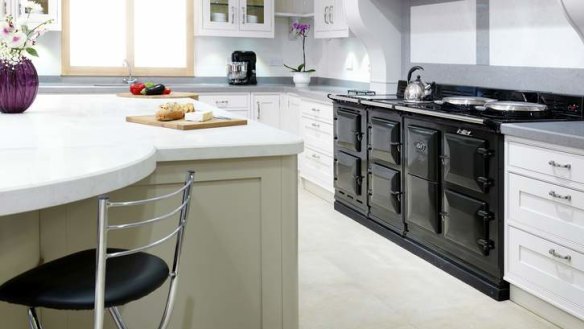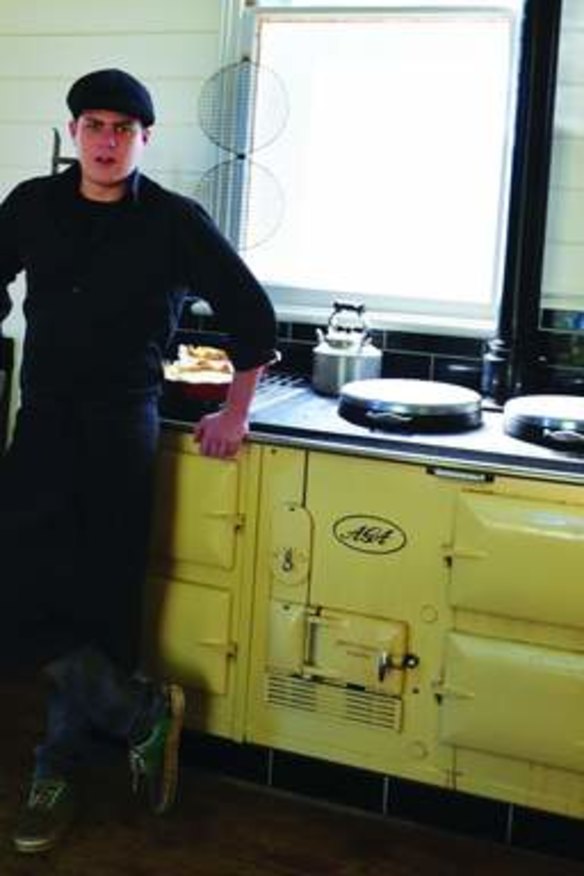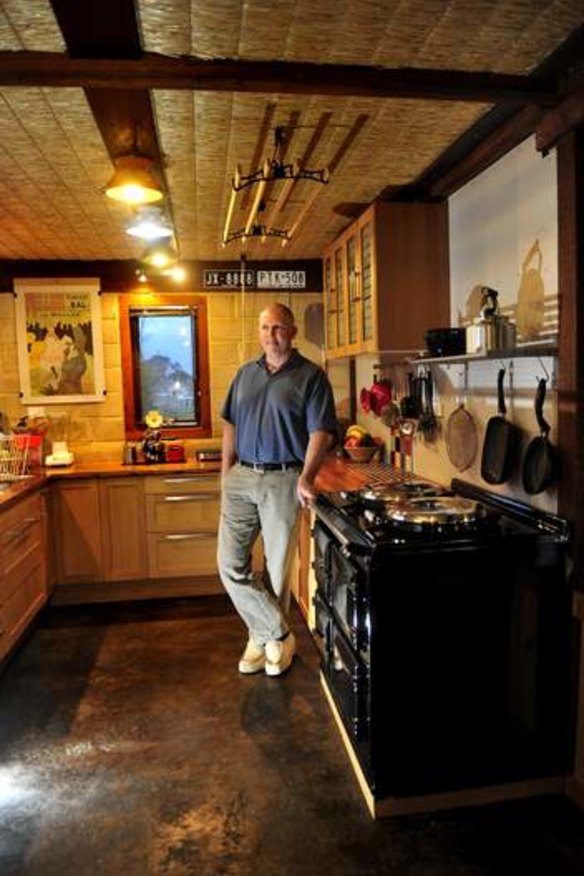Gaga about the Aga
The retro ovens are quite the thing in modern kitchen renovations, Danielle White writes

They have pride of place in more than 750,000 kitchens around the world. With their cast-iron good looks, they weigh about 500 kilograms apiece and people design their houses around them. What is it that makes the world go gaga about an Aga?
Although thought of as the embodiment of British country style, the Aga cooker was invented by a Swedish physicist, Nobel prize winner Dr Gustaf Dalen. Blinded by an acetylene explosion in 1912, the housebound Dalen learnt how labour-intensive it was for his wife Elma to tend their old-fashioned range. By 1922, he had designed an all-in-one cooker, water heater and laundry dryer that would more or less look after itself.
The first solid-fuel Aga cooker, which had a black top with white front panels, was sold in Britain in 1929. By 1932, 1705 cookers had been sold and by the mid-1950s, with the introduction of colours other than cream, they were selling at a rate of 50,000 a year.

So what is Aga's recipe for enduring success? Ask any admirer and the answer is equal parts its function and its form. The striking, solid cast-iron form absorbs, retains and radiates heat, keeping moisture and flavour in food. And they warm the house.
But isn't it all a bit slow-going? Are wood-fired ovens outdated? James McIntosh, a cookbook author and Aga ambassador, says that while Aga cookers evoke a good-old-days vintage aesthetic, the modern versions are high-tech and environmentally aware.
Aga still trades on its retro looks, with cast-iron construction and enamelled paintwork, but there is little retro about the technology. Most Agas now run on electricity or gas, or a combination, to heat the cast-iron body, with controls hidden behind a front panel. In 2011, Aga released a "Total Control" model, which can be turned off and on as needed or powered down to save running costs.

They're clearly no longer the preserve of country homes with access to a year-round wood supply. A classic cream Aga sits as comfortably in Frank Lloyd Wright's architectural masterpiece home in Pennsylvania, Fallingwater, as a sleek, black four-oven cooker sits in Gerard Depardieu's converted-theatre home in Paris.
Danielle White blogs at thecountryphiles.com
Peter Kopp, Murrumbateman
Peter and Jingming Kopp, of Murrumbateman, installed an Aga when he built the house 18 months ago, and they see it as a thing of beauty.
"It excites me every time I get home,'' Peter Kopp says. ''For me, an Aga is a symbol of a way of life that says it's not just important to get a job done, it's important to do a job really well, and to also do it with style."
He fell in love with Aga cookers when he saw one at a bed and breakfast in Daylesford. But his mother has a wood-burning Rayburn, and romantic as that is, Kopp knows it's hard work. So he opted for electricity.
"From a functional perspective, it is hands down the best cooker I've ever used. At the same time, it's a thing of real beauty, and I genuinely enjoy just looking at it. Nothing about an Aga is there for decoration, but it's incredibly beautiful all the same.''
Kopp says he puts the oven into "slumber mode" when they go on holiday, timing it to heat up again before they get home - if you turn it off completely, it takes a day to come up to full heat, he says. The controls are hidden behind a door in the top left of the oven, where you would have found the fire box in the old wood stoves.
Kopp says that while family and friends love the way the Aga looks, they "really get it" when they taste the food it cooks.
"Its looks always attract attention, and most people are fascinated by the concept of no temperature control. I know I'm dealing with a kindred spirit when I see growing interest and excitement as I explain what it's all about."
He likes the way it's always on, and it removes ''clutter'' from the kitchen as you don't need an electric kettle, a toaster or microwave. ''And at the end of the day, my wife puts her pyjamas on the Aga while she's in the shower so she can jump into toasty warm jim-jams afterwards."
The couple use it for slow-cooked meat, cooking cuts such as brisket, pulled pork, oxtail soup, roast goat leg, and Chinese-style pork belly. And when figs are in season, they have fig, prosciutto and feta pizza every Saturday night.
Kopp describes his wife as ''the world's foremost practitioner of Chinese cooking using an Aga''. ''I muscle in on the weekends," he says.
Robert and Jackie Power, family home, Kyneton
Country GP Robert Power and his wife Jackie Power, a practice manager, use their cream-coloured four-oven gas Aga with two hobs to cook the family meals, dry the kids' clothes and host regular parties, among them ''weekly All Creatures Great and Small-style doctors' lunches and 52 guests each Christmas".
Jackie Power says her mother persuaded her to buy the oven and now she can't imagine her home without it. "Our plans to do a modern renovation of our bluestone farmhouse were already in place and the kitchen almost completed when we advised the architect of our - well, my mum's - decision to put in a four-oven Aga.'' she says.
A wall was moved, alterations were made and she ordered the largest one she could fit in the space. ''I chose an exact replica of the one my grandmother had in Galway in Ireland, which was apparently the first Aga installed in the town,'' she says.
Power says she had always loved the look of Agas, but had been told a few "untruths". "People would say things like, 'It's a much slower way of cooking,' and 'You'll need to learn how to cook all over again,' which was the last thing I needed in a house with four growing children,'' she says.
She describes the oven as a necessity in her family's life. It's on all the time, other than those few days of summer when the temperature hits 35 degrees.
''It helps get the kids out of warm beds in the morning, dries their school clothes, wet runners and footy boots, and allows them to get creative and cook pancakes unsupervised on a relatively safe cooking appliance.''
Her Aga runs on gas - "It works on thermal mass. It's like a massive piece of steel that heats up and it stays hot.'' But yes, it comes with a price tag. The Aga cost the Powers just short of $24,000 installed.
Simon and Narelle Kudnig, Berribrae, Newham, Victoria
Simon and Narelle Kudnig installed their ''classic'' cream four-oven Aga when they built the house about two years ago.
''We put the Aga in the middle of the house and then just built the house around it,'' Simon says, only partially joking. ''It is the centrepiece, for sure. No other oven would suit the style of our house, which is based on my parents' 1800s sandstone house in Tasmania.''
Narelle Kudnig shows chooks, and uses the oven to help ''fluff'' the birds' feathers before a show. ''It sounds a bit odd, I know, but blow-drying the chooks' feathers doesn't get anywhere near as good a result as drying them with the Aga,'' she says. ''The radiant heat is so gentle.''
The electricity-powered oven cost them about $22,000, and Simon Kudnig says it provides enough radiant heat to keep the kitchen warm - without the need for any other heating - although it can get too hot in mid-summer.
''It's very functional and efficient and still has a romantic, charming design,'' he says.
Peter Stephens and Anna Charlesworth North Fitzroy, Melbourne
Melbourne real-estate agent Peter Stephens and designer Anna Charlesworth incorporated an Aga into their North Fitzroy renovation two years ago, opting for a style of Aga that is a little different in the way it works from a conventional oven. The difference, Stephens says, is in build quality, solidity and look - complete with hinged doors.
''I like the solidity of the Aga,'' Stephens says. ''We chose the cooker first, then had the kitchen designed with it in mind. I told the architect I wanted an Aga and he asked if he could pick the colour. Fortunately, we both liked black.''
His Aga, which cost just over $10,000, provides no radiant heat - the four ovens are electric and used just like a conventional electric oven, and the six burners on top are gas.
''I wanted something that's got the normal convenience,'' he says. ''I didn't want the big old round plates. I wanted the Aga build and the Aga look but not the old-style Aga.''
Sam King Darling Point, Sydney
Sam King has recently installed a new duck-egg blue mini Aga in her tiny one-bedroom 1950s apartment in Sydney's Darling Point.
''My friends are all trying to redo their kitchens so they can have one too,'' she says. ''I have a deep love for my Aga, and everyone who sees it has oven envy - including the plumber, electrician, joiner and designer … here during the renovations.''
King, who works in interior design, puts a dish in the slow oven before she leaves for work. ''I am a big cook, so I love that I have the gas hobs, super-deep ovens and a slow oven with the consistency of an electric oven and a fan-forced oven all in a tiny footprint that looks like a Tiffany and Co. jewel box.''
King's parents gave her the Aga as a gift.
Richard Dyson, Malmsbury, Victoria
Richard Dyson runs Small Holdings, a cafe and wine bar in a restored 1870s timber church in Malmsbury, country Victoria. In winter, he cooks in the open kitchen on a refurbished cream Aga cooker, and he says people lean up against the oven for warmth when the food's done.
''It's a hit with everyone,'' he says. ''People love the warmth it radiates and seeing it in action often reminds them of good times they've shared at family dinners in the past.''
The Aga, installed early last year, runs on gas for the stovetop and ovens, and Dyson says that - while he also has a conventional fan-forced oven for cooking in summer when it's too hot for the Aga - he trusts the Aga more. It gives a more gentle and consistent heat. Dyson uses the hobs to keep dishes warm. The day we visited he had three quiches and a pot of roast pumpkin and apple soup on top, and he uses the ovens for slow cooking.
Hot facts
■ An Aga cooker costs from $7400 to more than $30,000, depending on the model and configuration.
■ Aga is an acronym for aktiebolaget gas-accumulator, the name of a Swedish company that invented a system of storage for the acetylene gas used in lighthouses.
■ Aga cookers are manufactured at the company's Shropshire foundry, a National Heritage site. The company says 70 per cent of every Aga is made from recycled materials, such as cast-iron lamp posts.
■ The cookers come in 12 colours, with aqua introduced this year, and in two-, three- and four-oven models, powered by propane, kerosene heating oil, natural gas and electricity, as well as wood and coal.
The best recipes from Australia's leading chefs straight to your inbox.
Sign up